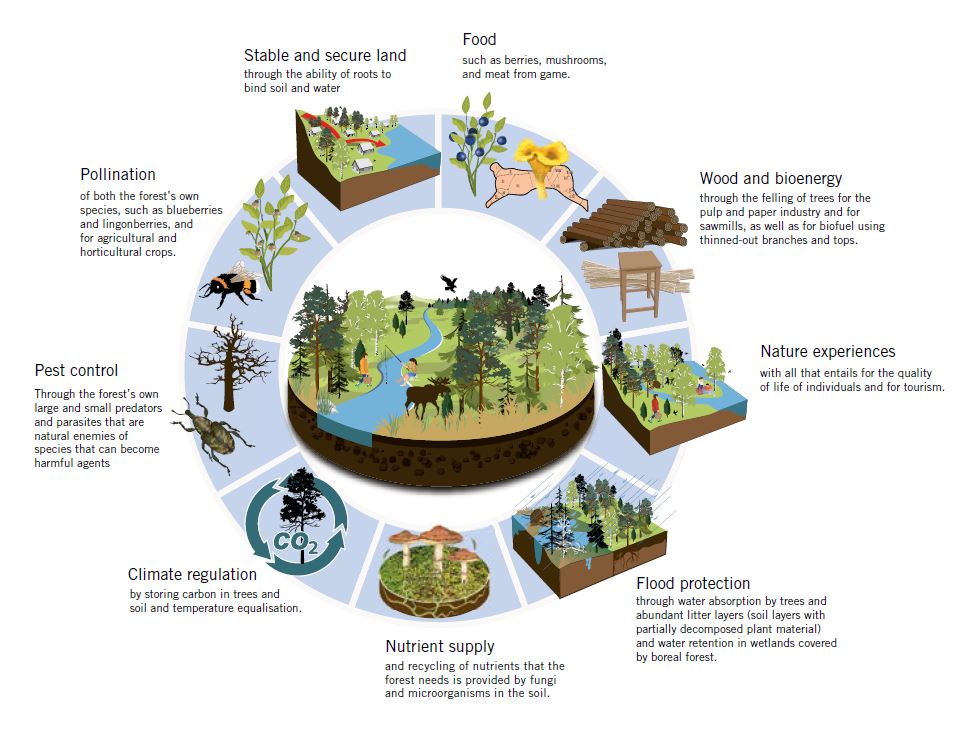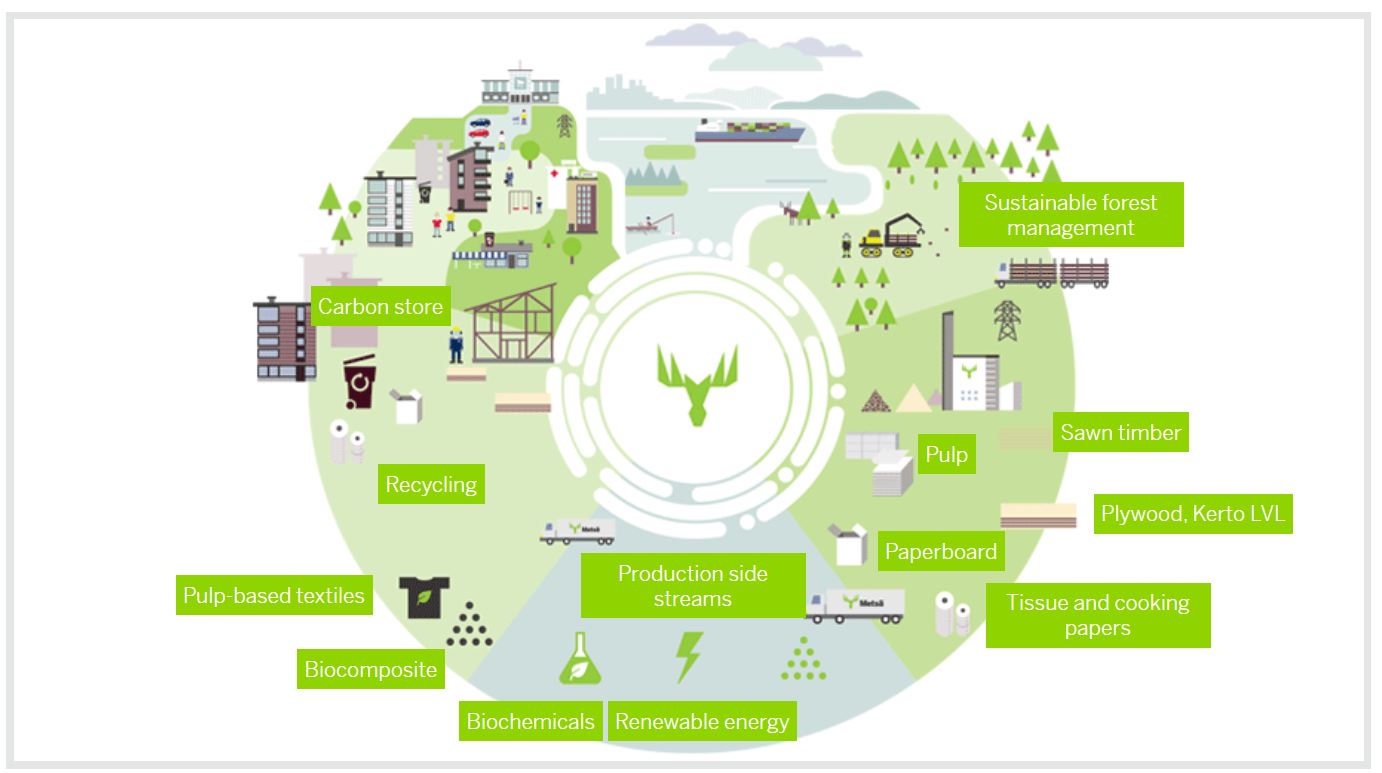The forest sector and the idea of circular bioeconomy
Mankind is searching for routes towards sustainable, circular bioeconomy. The goal is to gradually move away from the prevailing fossil-based economy, which is much based on single use of fossil resources, namely deposits of coal, oil and natural gas. The idea of bioeconomy is that various human needs and desires are fulfilled sustainably by using renewable natural resources like forests and increasingly replace the use of non-renewable fossil resources, such as oil, natural gas and coal.
Ecosystem goods and services
The concept of ecosystem goods and services addresses the strong connection between nature’s ecosystems and human welfare. The concept refers to such nature’s products and processes which contribute to human wellbeing. These include a wide range of goods like food (vegetables, meat, fish etc.), timber, and water and services like photosynthesis, pollination, natural regulatory systems, bioremediation of pollutants and waste, soil formation and so forth. (Figure 1) Thus, the wellbeing of forest ecosystems and the value of ecosystem goods and services they provide, is the foundation for circular bioeconomy 1,2. Related to this concept, also biodiversity is increasingly valued based on its essential functional role in the production of ecosystem goods and services; so-called functional biodiversity, rather than simply on species richness as such 3.

The forest sector
For the forest sector, which includes forestry and forest-based industries, the advance of circular bioeconomy offers opportunities for growth and diversification. Sustainability has become one of the most important driving forces of all aspects of our society. This places considerable pressure for the use of forests as well. The forest sector is actively searching for novel ways to increase the degree of wood processing, developing new products, manufacturing processes, and entirely new product areas as well as investigating ways of utilising side streams and enhancing material circulation.
However, it shouldn’t be taken for granted that being biobased always means being sustainable. To manage the forest sector’s sustainable growth and diversification also in the long term and globally, proper management of its impact on ecosystem services is of great strategic importance. Well-developed management practices throughout the value chain are essential, from tree seedlings to timber harvesting; from mill operations to product recycling, as illustrated in Figure 2.
Many useful definitions for bioeconomy have been formulated as general guidelines for translating the ideas discussed above into practice. In the context of ForestBioFacts learning environment, it is relevant to understand circular bioeconomy as the production, utilisation and conservation of biological resources, including related knowledge, science, technology, and innovation, to provide information, products, processes and services across all economic sectors aiming toward a sustainable economy 4. Adding circularity in the definition refers to both the global carbon cycle and the avoidance of waste by clever re-use, recovery and recycling of products, materials and energy. Such circularity is a key element in the strategy of the modern, efficient forest sector, making it the forerunner of the necessary global transformation 5.

Forestry and forest-based industries have a long history of bringing the idea of circular bioeconomy into practice by providing bio-based materials, chemicals and energy, as well as recreation to consumers. Collecting used paper and board products and reusing them in production adds to the sector’s resource efficiency. More recycled paper than virgin wood pulp is used as the feed stock in the paper and board industry, globally.
Forest sector, together with agriculture and the food industry, are the two largest producers and utilisers of bio-based resources. The modern forest sector employs experts from all branches of science and technology in its efficient industrial value chains. Professionals with competences varying from satellite imaging and drones to forest biology, sophisticated harvesting machinery and soil management; from robust mechanical engineering and advanced process automation to nanotechnology, integrated process chemistry and applications of biochemistry are needed.
Many of the technologies, which are developed and applied for industrial conversion of wood into value-added products, can also be adjusted and applied for doing the same from agricultural residues like various straws to enable further expansion of circular bioeconomy.
The global pressure for further diversifying the forest sector to produce sustainable, circular products to replace fossil-based products is now stronger than ever before.
Listen to what Research Professor Tekla Tammelin from VTT thinks about the future opportunities and challenges of bio-based materials.
Forests and sustainable bioeconomy
According to Food and Agriculture Organization of the United Nations (FAO,) forests cover 27 % or c. 4 billion hectares of the ground surface of Earth and contain 430 billion m3 of standing stock of growing trees 6. A little more than 500 million hectares of production forest are managed in compliance with either PEFC (Programme for the Endorsement of Forest Certification) or FSC (Forest Stewardship Council), the two most widely applied forest certification programs 7. These managed forests are developed, harvested and re-grown for the purpose of supplying renewable raw materials for bio-based products.
Well-managed production forests often also serve well for recreational purposes. For example, in Finland, where forests cover 75 % of the country’s land area, 100 % of production forests are such multi-purpose forests 6, and about 90 % of forests are certified either by PEFC or FSC – or both. 9, 17
After extensive, multi-disciplinary research work during several decades, scientists have established that human activities can, indeed, alter Earth’s atmosphere and climate in harmful ways, and are already doing so. While many details of the related complex global material and energy circulation are yet to be defined by scientists, there is good basis to attribute much of the observed and anticipated global warming and climate change to the rising atmospheric CO2 concentration. This rise is caused primarily by burning fossil fuels, but also by deforestation, which is mostly due to the growing needs of agriculture10.
The sophisticated calculation models, which are used to simulate the very complex system of Earth’s climate and oceans are continuously developed to explain its behaviour in detail, and to foresee the expected pace and intensity of future changes. Nevertheless, it’s already clear that mankind must adjust its raw material and energy supplies and its consumption patterns, even considerably, to mitigate damages and risks related to climate change 11,12. How high is the risk of the most dramatic visions to materialise is, and most likely will always be, debatable. Nevertheless, launching well-planned, knowledge-based actions is certainly justified.
Trees and other plants are made mostly of atmospheric carbon dioxide (CO2) through photosynthesis, driven by the energy of the sun’s radiation. About 50 % of the dry weight of wood is atmospheric carbon, corresponding to c. 1.8 tons of atmospheric CO2 bound per one dry ton of wood, or one ton of CO2 per one cubic meter of sawn timber 13. When plant biomass decomposes – either through natural decay, or, e.g., when combusted as fuel – carbon is again released back into atmosphere, mostly as CO
Indeed, forests have two essential roles in sustainable bioeconomy: as a source of primary raw material for bio-based products, enabling mankind to reduce the usage of coal, oil and natural gas, and as biological carbon storages and sinks. Using a certain forest resource for one of these purposes means that the same resource’s availability for the other purpose is limited to some extent. Nevertheless, e.g. in Finland and Scandinavia, well-managed, semi-natural production forests are considerable carbon sinks (i.e., growing carbon storages) while also providing increasing amounts of timber to be harvested from them.
This is made possible by well-developed forest management practices, which are based on applying the concept of ecosystem goods and services to boreal forests of these countries. The same concept and locally adjusted forest management practices have been successfully applied also to tropical planted forests14. Plantations established by major forest industry companies on degraded grasslands is a good example of this 15. However, there is still very big potential for improved forest management, especially in tropical forests.
As the markets of forest-based products are global, there is also another important trade-off. Reducing timber harvesting to increase forest carbon stocks in well-managed areas leads to increased harvesting in unmanaged forests elsewhere. This causes a negative net effect on carbon balance and ecosystems. Instead, curbing uncontrolled deforestation by employing good forest management enables policy makers and the forest sector to avoid such a harmful trade-off.
A key driver towards circular bioeconomy is the desire to reduce anthropogenic accumulation of carbon dioxide (CO2) in the atmosphere and to curtail its undesired consequences.
The forest sector provides many practical means for reducing the global economy’s dependence on fossil fuels and for bringing Earth’s carbon cycle back into balance.
Listen to when Dean Kristiina Kruus from Aalto University shares her thoughts on global challenges and how the forest industry and our engineers can solve them.
Further reading
- Antikainen R. (2017). Renewal of forest based manufacturing towards a sustainable circular bioeconomy. Reports of the Finnish Environment Institute 13/2017. http://hdl.handle.net/10138/186080
- Hetemäki et al. (ed.) (2017). Towards a sustainable European forest-based bioeconomy. European Forest Institute.
